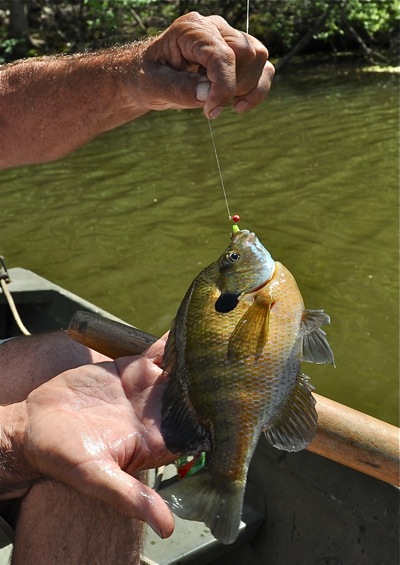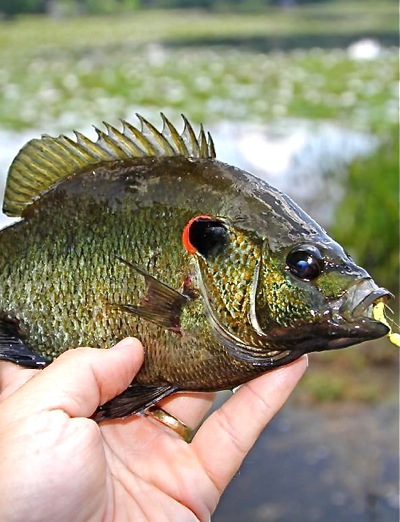They’re the most popular and accessible of all fish to catch, and probably the least sexy. But when it comes to just plain fun and the excitement of what might bite next, nothing beats catching bluegills.
Ed. Note: From time to time we get inquiries requesting outdoors and shooting stories from Tom Cappell. Cappell is a veteran shooter, hunter and free-lancewriter from Missouri whose views on the outdoors and the outdoors industry are thought-provoking and always responsible. His columns appear on Press Pros, sponsored by Olde English Outfitters, in Tipp City.
By Tom Cappell for Press Pros
 The first fish I ever caught was a bluegill. I was eight years old, and I remember this so well…fishing in the small stock pond on my Uncle Mel’s farm in Amlin, Missouri, using an old Zebco reel (that didn’t work properly), a can of worms (that I dug myself), and a small red-and-white bobber.
The first fish I ever caught was a bluegill. I was eight years old, and I remember this so well…fishing in the small stock pond on my Uncle Mel’s farm in Amlin, Missouri, using an old Zebco reel (that didn’t work properly), a can of worms (that I dug myself), and a small red-and-white bobber.
It was in the spring, as fish were gathering to spawn, and you could sight them just under the water, milling about, presenting an intoxicating target for success. Just put that worm in front of the biggest one you could reach and wait for him to take the bait.
Here’s what I remember. When the one you wanted would strike, pull on the line taking the bobber beneath the water’s surface, and fought to the point of bending my light fiberglass rod. Then, when you lifted him out of the water, how much smaller he appeared than you thought. The water, you see, works like a magnifying glass. It took me years to figure it out – that the bluegills you really want to catch are the ones you don’t see.
But I also learned that they’re there, and that’s the excitement of bluegill fishing. Pound for pound, there’s no better fish to catch, or eat, or manage for size than bluegills, and they’ve kept me hooked now for nearly sixty years. They say that hope springs eternal in matters of young boys and baseball? I’m not arguing. But I’m also stating the personal case…that while I like baseball, I like bluegills a whole lot more.

What I consider a good bluegill…a fish that’s five to seven years old, in a healthy environment, can reach ten inches.
The exciting part of bluegills is not unlike the exciting part of catching any fish. The more you know, the bigger the fish you catch. Spring is prime time for the ‘king’ of panfish – spawning time, and their aggressive nature to protect they’re environment and they’re nest. Find a shoreline with a little structure underneath (brush or some other feature of cover and protection) and you’re going to find bigger, better bluegills. As the temperature rises towards May and summer (post-spawn), you’ll find the better fish in deeper water. Mess with their aggressive personalities, and you’ll catch some of those better fish.
Worm fishing works fine on smaller, adolescent fish. But like people, as bluegills grow they become more discerning with their eating habits. They’ll still eat worms, but presentation becomes more a factor. That’s why so many ‘good’ bluegill fishermen have mastered the art of small, bright, ‘jig’ baits, where color and motion become attractive and addictive to bigger, more adult fish. They’re territorial to some extent, and if they think something doesn’t belong there it will entice them to respond and attack.
They also tend to school, and where you catch one bigger fish, you’re likely to catch more. What is a good bluegill? Well, ten inches has always been the standard of a ‘better’ fish in my mind, and that’s a fish that’s probably five to seven years old, in a healthy, food-rich environment without competition from ‘stunted’ smaller fish. And the bass population in a body of water also has something to do with the quality (size) of bluegill that you catch.

They’re really red-eared sunfish (look close and you’ll see why), but variations of the bluegill in deep creeks and rivers are called ‘shellcrackers’.
And here’s another factor, good bluegill water gets fished regularly, and managed. That means, taking out smaller fish to make bigger fish a priority – lessen the competition for food and territory. My Uncle Mel would take a bucket of smaller fish back to the house and plant them in Aunt Floy’s flower beds for fertilizer. As they decomposed the leaves on her roses became a deep, waxy green in appearance, and the blooms doubled in size.
But the point of this writing is this. Like any other fish, you can catch good bluegills, and you can catch better bluegills. And the fun of it is discovering where, and how. Find cover, adapt to the season, and remember that while they’re small, bluegills are predatory.
The biggest one I’ve ever caught was 13 inches, a true trophy, and that fish stands as one of my most exciting moments. Before I was done that day I had about a dozen that were ten to twelve inches. But don’t be greedy. Don’t overf-ish. Just remember the date, the conditions, and the kind of cover that brought you success. Leave some, and they’ll be there for you again.
I’m thinking of some of those places now. And how what I’ve learned works on any kind of water where structure and deeper pools can mean bigger, better bluegills – creeks and rivers – where you often find variations on the true bluegill…red-eared sunfish, what some people call ‘shellcrackers’. And fishing being fishing…even a few smallmouth bass. It’s just a couple of weeks away.
And still exciting to me.

